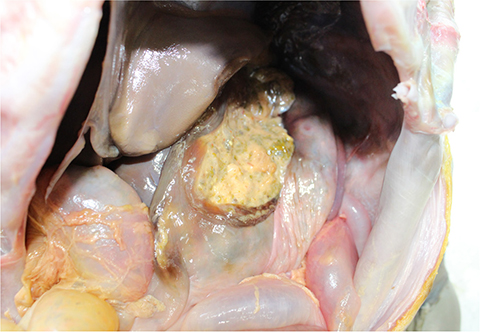Korean J Leg Med.
2020 Feb;44(1):45-47. 10.7580/kjlm.2020.44.1.45.
Gastromalacia (Postmortem Gastric Perforation): Two Cases Reports
- Affiliations
-
- 1Department of Forensic Medicine, School of Medicine, Kyungpook National University, Daegu, Korea. sanghan1@knu.ac.kr
- KMID: 2471745
- DOI: http://doi.org/10.7580/kjlm.2020.44.1.45
Abstract
- Gastromalacia refers to the postmortem acute autolytic erosion of the gastric wall. It should be distinguished from gastric perforations caused by antemortem injuries or other pathologic processes, such as ulcer perforations. It appears as a slimy brownish-black perforation of the gastric wall. The diagnosis is based on the presence of a typical macroscopic perforation in the fundic portion of the stomach, lack of vital reactions in the adjacent organs, and lack of clinical or autopsy evidence of trauma. Here, we report two cases of gastromalacia: one in a 53-year-old woman who died from severe head injury and another in a 2-year-old child who died from neglect by his father. Gastromalacia is a welldefined phenomenon, but due to its rarity in the practical work, it could be misdiagnosed as other causes of gastric perforation.
Keyword
MeSH Terms
Figure
Reference
-
1. Hunter J. On the digestion of the stomach after death. Philos Trans R Soc Lond. 1772; 62:447–452.
Article2. Perper JA. Time of death and changes after death. In : Spitz WU, editor. Medico-legal investigation of death: guidelines for the application of pathology to crime investigation. 4th ed. Springfield, IL: Charles C Thomas;2006. p. 14–49.3. Usui A, Kawasumi Y, Hosokai Y, et al. Postmortem radiography of gastromalacia: case reports. Jpn J Radiol. 2013; 31:637–641.
Article4. De-Giorgio F, Lodise M, Pascali VL, et al. An unusual case showing fatal rupture of a gastric ulcer or gastromalacia? The importance/role of histology for differential diagnosis. J Forensic Sci. 2015; 60:240–242.
Article5. Bell LG, Thomas EE Jr, Skillicorn SA. Gastromalacia; a review and report of one case with recovery. Ann Surg. 1956; 143:106–111.6. Laczniak AN, Sato Y, Nashelsky M. Postmortem gastric perforation (gastromalacia) mimicking abusive injury in sudden unexplained infant death. Pediatr Radiol. 2011; 41:1595–1597.
Article7. Tejerina Alvarez EE, Holanda MS, Lopez-Espadas F, et al. Gastric rupture from blunt abdominal trauma. Injury. 2004; 35:228–231.
Article8. Larson GM, Koch S, O'Dorisio TM, et al. Gastric response to severe head injury. Am J Surg. 1984; 147:97–105.
Article
- Full Text Links
- Actions
-
Cited
- CITED
-
- Close
- Share
- Similar articles
-
- Discrepancies in the Cause and Manner of Death Reported in Postmortem Inspection and Autopsy
- A Giant Gastric Perforation Occurring in the Normal Mucosa during Endoscopy in a Patient with Advanced Gastric Cancer
- Iatrogenic Gallbladder Perforation during Gastric Endoscopic Mucosal Resection
- Perforation of a Gastric Tear during Esophageal Endoscopic Submucosal Dissection under General Anesthesia
- The Case of Pseudocyst Formation after Spontaneous Neonatal Gastric Perforation



